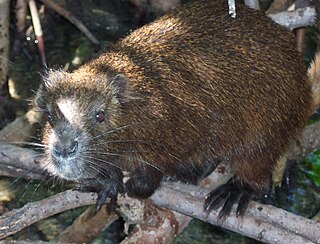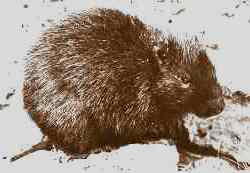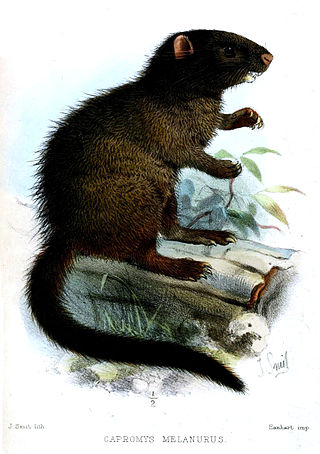
Gonzalo Fernández de Oviedo y Valdés, commonly known as Oviedo, was a Spanish soldier, historian, writer, botanist and colonist. Oviedo participated in the Spanish colonization of the West Indies, arriving in the first few years after Christopher Columbus became the first European to arrive at the islands in 1492. Oviedo's chronicle Historia general de las Indias, published in 1535 to expand on his 1526 summary La Natural hystoria de las Indias, forms one of the few primary sources about it. Portions of the original text were widely read in the 16th century in Spanish, English, Italian and French editions, and introduced Europeans to the hammock, the pineapple, and tobacco as well as creating influential representations of the colonized peoples of the region.

Hutias are moderately large cavy-like rodents of the subfamily Capromyinae that inhabit the Caribbean islands. Most species are restricted to Cuba, but species are known from all of the Greater Antilles, as well as The Bahamas and (formerly) Little Swan Island off of Honduras.
The dwarf hutia is a small, critically endangered, rat-like mammal known only from Cuba. Aside from tracks, it was last seen in 1937 and may be extinct. It gives birth to only a single offspring at a time, and is threatened by habitat loss and non-native species such as rats and mongoose. The dwarf hutia belongs to the hutia subfamily (Capromyinae), a group of rodents native to the Caribbean that are mostly endangered or extinct.
Garrido's hutia is a small, critically endangered, rat-like mammal found in coastal mangrove forests on Cuba and nearby islands. It is rarely seen and may be extinct. It is a member of the hutia subfamily (Capromyinae), a group of rodents native to the Caribbean that are mostly endangered or extinct. The only other species in its genus, the Desmarest's hutia, is also found only on Cuba.

Geocapromys is a genus of rodent belonging to the hutia subfamily and are currently only found on the Bahamas and Jamaica. However, they formerly ranged throughout the Caribbean, from Cuba to the Cayman Islands to even islands off mainland Central America.

The Jamaican coney, also known as the Jamaican hutia or Brown's hutia, is a small, endangered, rat-like mammal found only on the island of Jamaica. About the size of a rabbit, it lives in group nests and is active at night to feed on fruit, bark, and other plant matter. It is currently endangered by habitat loss, hunting, and non-native species; it persists only in remote mountains. The Jamaican coney belongs to the hutia subfamily (Capromyinae) and is the only surviving native mammal on Jamaica other than bats.

The Hispaniolan hutia is a small, threatened, rat-like mammal endemic to forests on the Caribbean island of Hispaniola. It lives in burrows or trees, and is active at night when it feeds on roots and fruits. A member of the hutia subfamily (Capromyinae), it is endangered from habitat loss and introduced species, such as rats or feral dogs.

Desmarest's hutia or the Cuban hutia is a stout, furry, rat-like mammal found only on Cuba and nearby islands. Growing to about 60 cm (2 ft), it normally lives in pairs and feeds on leaves, fruit, bark and sometimes small animals. It is the largest living hutia, a group of rodents native to the Caribbean that are mostly endangered or extinct. Desmarest's hutia remains widespread throughout its range, though one subspecies native to the nearby Cayman Islands went extinct shortly after European colonization in the 1500s.
The Hispaniolan edible rat is a recently extinct species of rodent in the family Echimyidae. It is the only species in the genus Brotomys. It was endemic to the island of Hispaniola in the Caribbean, in what is today the Dominican Republic and Haiti. Its natural habitat was subtropical or tropical moist lowland forests.

The Bahamian hutia or Ingraham's hutia is a small, furry, rat-like mammal found only in the Bahamas. About the size of a rabbit, it lives in burrows in forests or shrubland, emerging at night to feed on leaves, fruit, and other plant matter. It was believed extinct until rediscovery in 1964, and it remains the focus of conservation efforts. The Bahamian hutia is a member of the hutia subfamily (Capromyinae), a group of rodents native to the Caribbean, many of which are endangered or extinct.
The montane hutia is an extinct species of rodent in the subfamily Capromyinae. It was endemic to Hispaniola.

Cabrera's hutia is a small, critically endangered, rat-like mammal found only in Cuba. It lives in communal shelters in swamps and coastal mangrove forests, and is threatened by habitat loss. It is a member of the hutia subfamily (Capromyinae), a group of rodents native to the Caribbean that are mostly endangered or extinct.
The eared hutia or large-eared hutia is a small, endangered, rat-like mammal found only on the Caribbean island of Cayo Fragoso, off the north coast of Cuba. It lives in coastal mangrove forests and swamps, and is threatened by habitat loss. It is a member of the hutia subfamily (Capromyinae), a group of rodents native to the Caribbean that are mostly endangered or extinct.

The black-tailed hutia, also known as the bushy-tailed hutia, is a small, furry, rat-like mammal found only in Cuba. It lives in lowland moist forests and is threatened by habitat loss. It is a member of the hutia subfamily (Capromyinae), a group of rodents native to the Caribbean that are mostly endangered or extinct.
The Isla De La Juventud tree hutia or southern hutia is a subspecies of rodent in the subfamily Capromyinae. It is endemic to lowland moist forests on Isla de la Juventud in Cuba. It is threatened by habitat loss and is considered Critically Endangered by the IUCN Red List.

The prehensile-tailed hutia is a small, furry, rat-like mammal found only in forests on Cuba. It is the only member of the genus Mysateles. It climbs and lives in trees where it eats only leaves, and it is threatened by habitat loss. The prehensile-tailed hutia is a member of the hutia subfamily (Capromyinae), a group of rodents native to the Caribbean that are mostly endangered or extinct.

The San Felipe hutia, also known as the little earth hutia, is small, critically endangered, rat-like mammal found on the small island of Cayo de Juan Garcia off the southwest coast of Cuba. It was discovered in 1970 and is possibly extinct. Little is known about the species, except that it lives in swamps and coastal mangrove forests. It is a member of the hutia subfamily (Capromyinae), a group of stout rodents native to the Caribbean that are mostly endangered or extinct.

Echimyidae is the family of neotropical spiny rats and their fossil relatives. This is the most species-rich family of hystricognath rodents. It is probably also the most ecologically diverse, with members ranging from fully arboreal to terrestrial to fossorial to semiaquatic habits. They presently exist mainly in South America; three members of the family also range into Central America, and the hutias are found in the West Indies in the Caribbean. Species of the extinct subfamily Heteropsomyinae formerly lived on Cuba, Hispaniola, and Puerto Rico in the Antilles.











